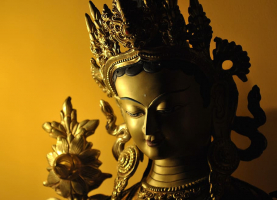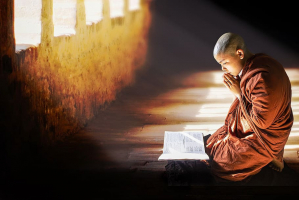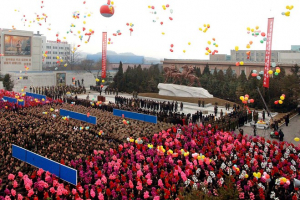Top 10 Most Famous Local Gods And Demons in Buddhism
Buddhism features many deities and supernatural beings that hold a significant place within its cosmology. Let us delve into the most famous local gods and ... read more...demons in Buddhism, each with unique roles and significance.
-
Mahakala, an eminent deity within Vajrayana Buddhism, is widely acknowledged as a guardian and protector figure, extending his significance beyond local confines. He profoundly influences various Buddhist traditions, particularly in Vajrayana or Tibetan Buddhist practices. Revered for his capacity to dispel hindrances, safeguard teachings, and offer swift aid to practitioners confronting trials, Mahakala embodies unwavering support in the spiritual journey.
With a visage of ferocity, Mahakala represents the alchemical shift from destructive energies to buoyant forces. His portrayal often features a fierce countenance adorned with embellishments crafted from human bones and skulls, symbolic of life's impermanence. As guardian and protector, Mahakala is invoked to shield against obstacles, negativity, and detrimental influences obstructing the path of enlightenment.
Though Mahakala's influence transcends geographical confines, his awe, and practices have permeated diverse regions where Vajrayana Buddhism thrives—spanning Tibet, Nepal, Bhutan, and segments of India. Devotees harness the potency of Mahakala's essence through rituals, mantras, and visualizations, nurturing inner resilience and surmounting spiritual and worldly impediments.
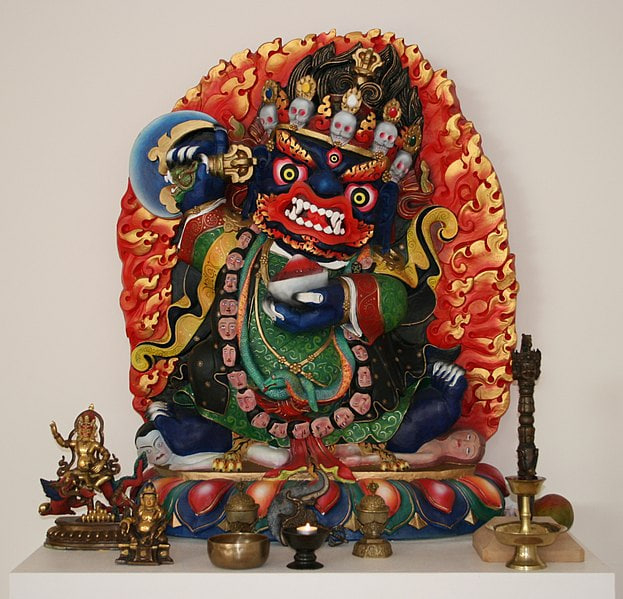
Photo on Wikimedia Commons (https://commons.wikimedia.org/wiki/File:Mahakala_Bernakchen.jpg) Video by Masters of Buddhism -
Hariti, a figure revered within Buddhist and Hindu traditions, emerges as a compassionate mother goddess in her depictions. Her narrative transcends geographical borders, echoing through the diverse tapestry of Buddhist cultures, spanning South Asia to East Asia. The reach of her reverence extends to the farthest corners where Buddhism flourishes, underscoring the universal resonance of maternal love and boundless compassion.
In the annals of Buddhist lore, Hariti transforms from an evil spirit who causes harm to children into a benevolent deity who safeguards them. Celebrated in her maternal guise, she embodies the sentinel of children's well-being, caring, sustenance, and an outpouring of affection.
As she evolves into a compassionate mother goddess, Hariti's iconography shifts, now embodying the essence of fertility and nurturing motherhood. Her portrayal radiates warmth, often cradling children and enveloped in an aura of abundance, vividly manifesting her roles as provider and guardian.
Practitioners engage in rituals, prayers, and offerings, seeking Hariti's blessings to bestow children's health, security, and prosperity. Her embodiment as a mother goddess becomes a beacon of nurturing solicitude, harmonizing cultures and beliefs within her universal embrace.
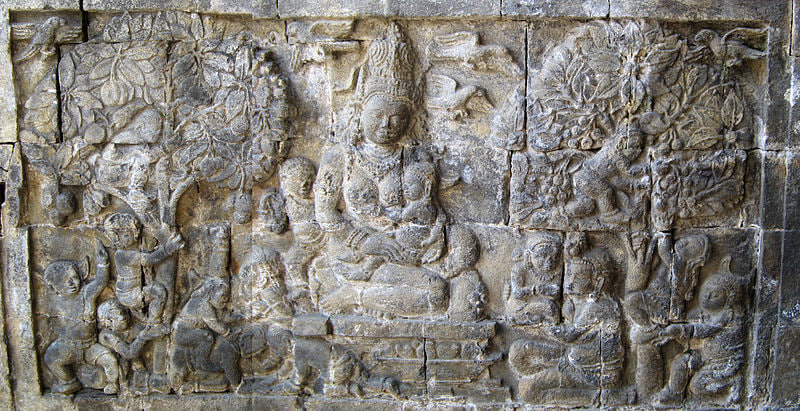
Photo on Wikimedia Commons (https://commons.wikimedia.org/wiki/File:Relief_of_Hariti,_Candi_Mendut,_Java_1039.jpg) Video by Grandeur of Gandhara -
Another famous local god in Buddhism is Kuvera - the god of wealth. Kuvera, also recognized as Vaisravana, commands reverence as the deity of luxury and affluence within Hinduism. Often depicted as the sovereign of the yakshas and ruler of the mythical Himalayan kingdom of Alaka, Kuvera epitomizes prosperity. In select Buddhist realms, particularly in Tibetan Buddhism, Kuvera's presence is seamlessly woven into the pantheon, assuming the mantle of a guardian and protector figure.
In regions where the harmonious coexistence of Buddhist and Hindu traditions prevails, such as Nepal and segments of Southeast Asia, Kuvera's attributes of wealth and safeguarding have harmoniously merged into Buddhist practices. He is occasionally invoked to bestow blessings linked to material well-being, abundance, and the alleviation of obstacles.
It is noteworthy that Kuvera's acknowledgment within specific Buddhist contexts does not attain the same centrality as witnessed in Hinduism. The assimilation of Kuvera into Buddhist observances magnifies the ever-evolving tapestry of religious interplay and syncretism. Deities from distinct traditions harmonize within this dynamic realm, finding resonance and significance amid novel cultural and spiritual landscapes.
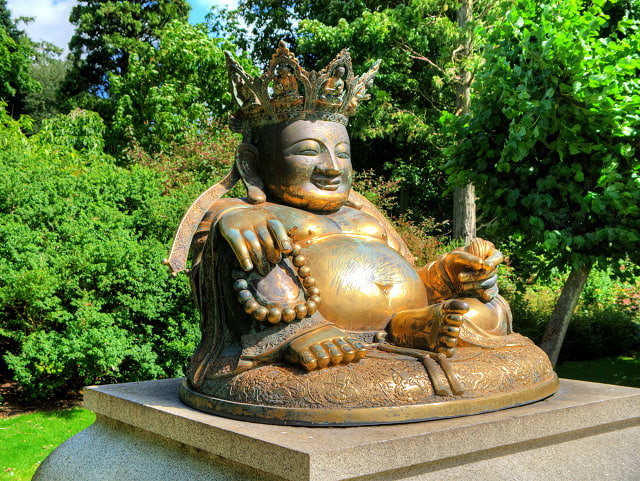
Photo of https://www.geograph.org.uk/photo/4611177 Video by Epified -
While Hayagriva's origins lie within Hindu mythology, his integration into specific Buddhist traditions, notably Tibetan Buddhism, has given him a unique and pronounced role as a guardian and a deity. Emanating a distinctive identity, Hayagriva assumes the form of a horse-headed god, embodying the profound attributes of knowledge, wisdom, and the conquest of ignorance.
Hayagriva garners reverence as a vigilant guardian, proficient in dispelling obstacles, particularly those obstructing spiritual progress and intellectual growth. Devotees invoke his protective aura to shield against negative influences and to fortify their comprehension and insight.
The assimilation of Hayagriva into Tibetan Buddhism's framework is a striking example of the syncretic nature intrinsic to religious traditions. Deities drawn from diverse sources discover renewed relevance and significance within the evolving context of spirituality. As he transitions from his original Hindu roots, Hayagriva's inclusion within select Buddhist practices underscores Buddhist beliefs' adaptive and malleable essence, readily embracing a tapestry of influences.
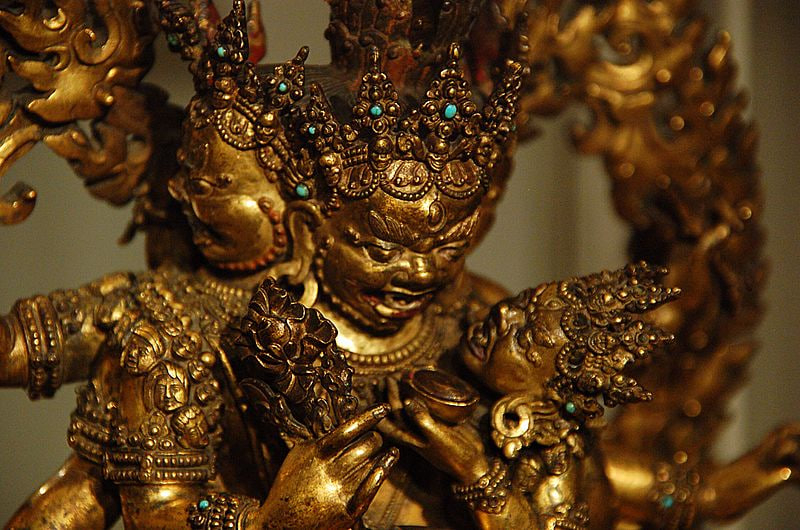
Photo on Wikimedia Commons (https://commons.wikimedia.org/wiki/File:Hayagriva,_gardien_de_la_doctrine_%28dharmapala%29,_et_sa_par%C3%A8dre_%2814131726178%29.jpg) Video by Himalayan Art Resources, Inc. -
Tara, an esteemed and revered female deity, embodies the virtues of compassion, safeguarding, and illumination. Her significance transcends cultural borders, carving a central niche within the devoted hearts of practitioners.
Tara emerges as an embodiment of swift compassion, poised to alleviate suffering and steer beings toward liberation. Her myriad forms, encapsulated in the 21 Taras, each radiate distinct attributes, extending guidance and solace across multifaceted dimensions of existence.
Symbolizing wisdom and nurturing care, Tara deeply resonates with seekers in search of solace and empowerment. Her benevolent essence takes center stage in rituals and prayers, where devotees invoke her grace for healing, guidance, and spiritual expansion.
Tara's universal presence spans the spectrum of Buddhist traditions, seamlessly traversing from Tibetan Buddhism to Theravada Buddhism. She defies the confines of cultural boundaries, serving as a wellspring of comfort and inspiration to innumerable souls on their sacred odyssey.
In its essence, Tara's revered stature as a female deity illuminates the expansive and embracing nature of Buddhist convictions. Her prominence underscores the pivotal roles of compassion, wisdom, and protective vigilance in steering devotees along the transformative path toward enlightenment and inner metamorphosis.
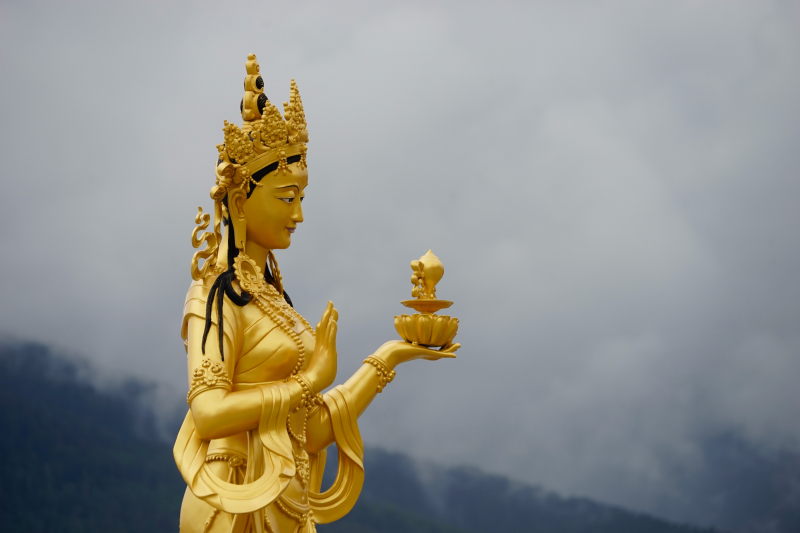
Photo on Pexels (https://www.pexels.com/photo/gold-statue-in-close-up-shot-7786832/) Video by Masters of Buddhism -
Mara, renowned and widely acknowledged within Buddhism, is frequently depicted as an evil deity or demon, symbolizing the influences of illusion, desire, attachment, and delusion. He personifies the impediments and diversions that obstruct sentient beings from reaching enlightenment and breaking free from the cycle of samsara.
One prominently recognized occurrence involving Mara is the narrative of the "temptation of Buddha," unfolding amid Siddhartha Gautama's meditation beneath the Bodhi tree. As Siddhartha stood on the cusp of enlightenment, Mara endeavored to hinder his advancement by introducing an array of temptations and illusions to divert him from his chosen path.
In the face of Mara's endeavors, Siddhartha maintained an unwavering composure, gently touching the earth with his right hand as a gesture of connection and testimony. Subsequently, the earth goddess materialized, attesting to Siddhartha's myriad virtuous actions across his previous lifetimes. This unwavering determination prompted Mara and his forces to retreat, paving the way for Siddhartha's enlightenment and transformation into the revered Buddha.
Mara's narrative is imbued with profound symbolism, portraying the internal and external hurdles encountered by individuals traversing the journey to enlightenment. The enticements posed by Mara epitomize a spectrum of desires and diversions that engender suffering and impede the realization of spiritual awakening.
Mara's importance transcends being a mere demon archetype; he encapsulates the intricate interplay involving human psychology, desires, and the quest for spiritual emancipation. His tale serves as a poignant reflection of the trials and allurements individuals must face and conquer while pursuing awakening within Buddhist practice.
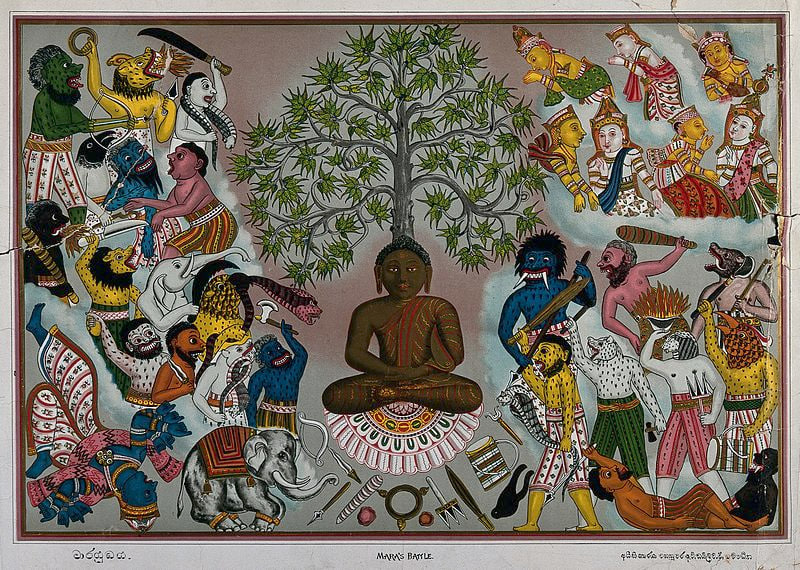
Photo on Wikimedia Commons (https://commons.wikimedia.org/wiki/File:Buddha,_resisting_the_demons_of_Mara,_Wellcome_V0046085.jpg) Video by Ajahn Sona -
Yama, a prominent and formidable local demon entrenched in Buddhist lore, symbolizes the relentless nature of death and the fleeting essence of life. Across diverse Buddhist traditions, Yama is a poignant reminder, emphasizing the impermanence that shapes the destinies of all sentient beings.
Portrayed as an awe-inspiring figure, Yama reigns over the realm of the deceased, overseeing the intricate process of rebirth. Often depicted as a discerning judge, he meticulously weighs the karma of departed souls, determining their trajectory within the cycles of samsara.
Yama's formidable countenance underscores the profound weight of human existence, propelling practitioners to confront the ultimate verity of mortality and the profound implications of virtuous conduct. His identity as a local demon is not evil but a symbolic embodiment of the karmic repercussions that unfold in the realm beyond.
By confronting the domain governed by Yama and acknowledging the inescapable reality of death, individuals are motivated to nurture ethical behavior, cultivate mindfulness, and deepen their spiritual insight. Yama sparks profound introspection, urging devotees to contemplate life's ephemeral nature and embrace the transformative path toward liberation.
In essence, Yama's stature as a revered local demon in Buddhism illuminates the potent capacity for personal transformation by acknowledging life's impermanence. His embodiment catalyzes spiritual contemplation, extending an invitation to embark upon a profound journey of self-discovery, virtuous living, and liberation from the perpetual cycles of birth and rebirth.
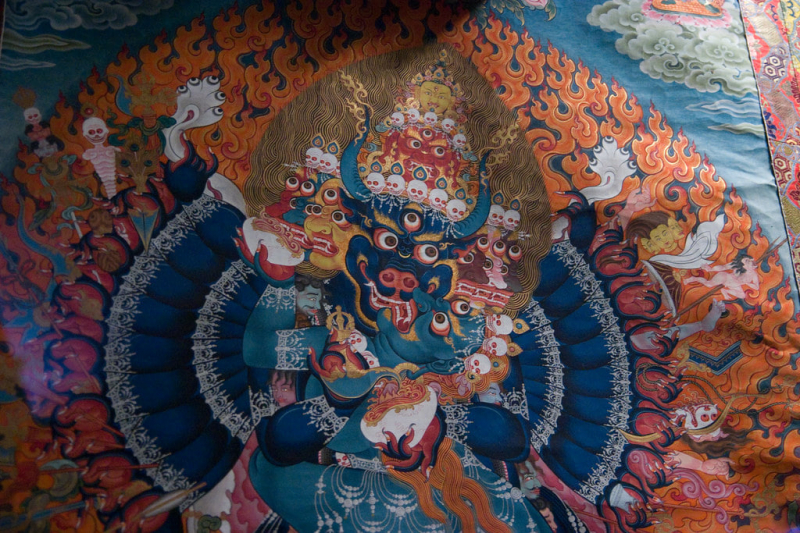
Photo on Flickr (https://www.flickr.com/photos/joeywan/3889495645) Video by Himalayan Art Resources, Inc. -
Nāga, held in reverence and renowned, emerges as a foremost local presence intricately woven into the rich tapestry of Buddhism. These serpent-like beings inhabit a pivotal realm within Buddhist cosmology, bearing profound significance across a spectrum of Buddhist traditions.
Portrayed as divine guardians and potential agents of disruption, Nāgas embody the intricate balance of existence. In certain accounts, they assume the mantle of protectors of hallowed sites and repositories of wisdom, while in others, they manifest as formidable figures intertwined with natural elements and waterways.
Nāga is a sphere of influence that transcends the bounds of myth, as their presence weaves through terrestrial and spiritual realms. Their interactions with humanity are laced with benevolence and caution, reflecting the intricate nuances of their role as intermediaries bridging diverse dimensions.
In Buddhist narratives, Nāgas is significance harmonizes with the teachings of impermanence and interdependence. Their manifestation mirrors the ephemeral nature of being, reverberating with the rhythm of birth, death, and rebirth. Their encounters with the historical Buddha and other enlightened beings underscore their potential for metamorphosis and enlightenment.
In essence, Nāga's exalted status as a revered local presence within Buddhism resonates with the profound wisdom of impermanence and interconnectedness. Their dynamic role encompasses safeguarding, enlightenment, and cosmic energies, inviting practitioners to delve into the intricate interplay connecting humanity, nature, and the spiritual realm.
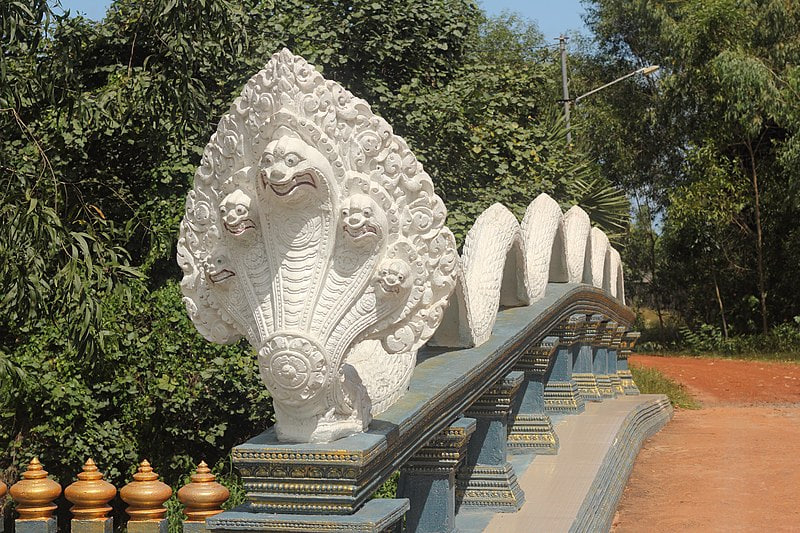
Photo on Wikimedia Commons (https://commons.wikimedia.org/wiki/File:Naga_-_Buddhism.jpg) Video by Mythology - Folklore A-Z -
In Tantric Buddhism, Ekatotsarajas - wrathful deities are depicted with fierce and dynamic forms, representing spiritual practice's forceful and transformative nature. They symbolize the energy required to overcome obstacles and opposing forces on the path to enlightenment.
Ekatotsaraja embodies a complex interplay of symbolism, reflecting both the potential for enlightenment and the challenges that beset the spiritual journey. These wrathful attributes symbolize the deity's power to subdue and conquer adversities. The deity's many arms hold weapons, such as swords, vajras (indestructible spiritual armaments), and flames, used to defeat and destroy obstacles and evil beings.
Ekatotsaraja's fierce appearance and the symbolism of his weapons represent the practitioner's inner strength and determination to conquer inner and outer negativities. The deity's image serves as a reminder of the transformative potential of embracing and harnessing intense emotions and energies for spiritual growth.
Ekatotsaraja's influence extends beyond mere myth, entwined with the intricate threads of human experience. As a local demon, this figure is a powerful allegory for the trials encountered on the path to enlightenment. His presence invites practitioners to confront inner challenges, transcend obstacles, and journey toward profound realization.
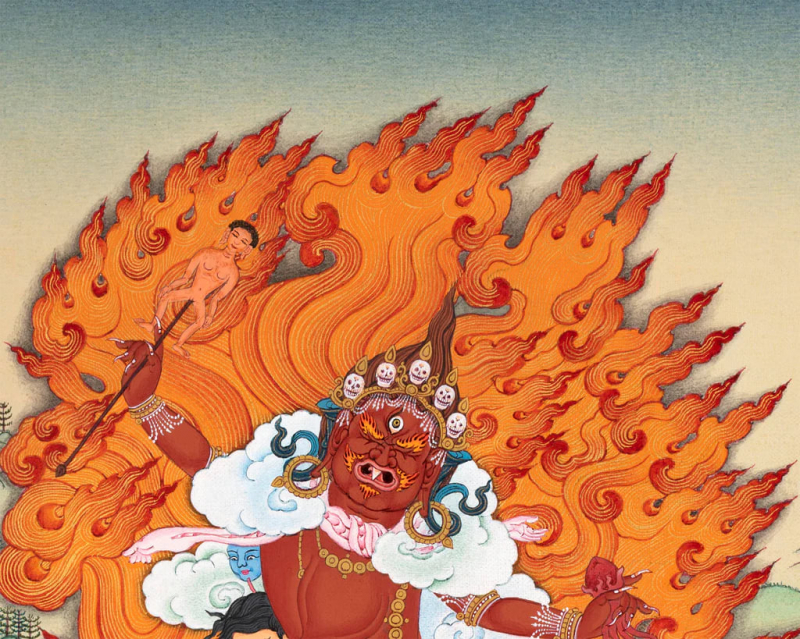
Screenshot of https://enlightenmentthangka.com/products/ekajati-vajra-tara-thangka Video by Masters of Buddhism -
Preta, a resonant name that echoes throughout Buddhist teachings, is one of Buddhism's most recognizable and emotionally impactful local demons. These enigmatic entities hold a significant position within Buddhist lore, embodying themes of suffering, desire, and the intricate workings of karma.
Depicted as pitiable and tormented spirits, Pretas symbolize the ceaseless hunger and insatiable cravings that tether beings to the cycle of suffering. Their haunting existence is a powerful reminder of the repercussions of uncontrolled longing and attachment.
The presence of Pretas extends beyond mere myth, casting a reflective lens onto the human experience itself. As local demons, they epitomize the challenges faced by those trapped in the relentless pursuit of worldly gratifications, accentuating the dangers of unchecked desires.
Embedded within Buddhist narratives, Pretas vividly illustrate the delicate equilibrium between compassion and responsibility. While their anguish is profound, it is also a consequence of their past deeds. This duality underscores the intricate interplay between individual choices and the outcomes they generate.
The prominence of Pretas as poignant local demons within Buddhism encapsulates the essence of suffering and the tenacious hold of desires on the human psyche. Their depiction functions as a cautionary narrative, urging practitioners to confront the complexities of their attachments and aspire toward a path of liberation from the ceaseless cycle of suffering.
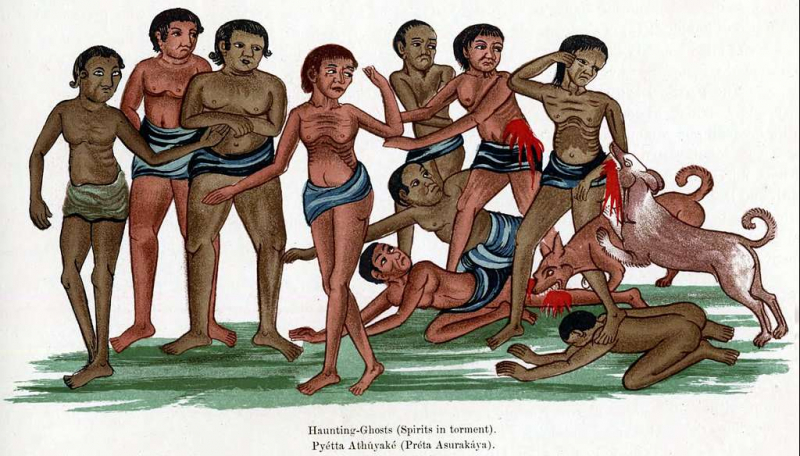
Photo of https://garystockbridge617.getarchive.net/amp/media/pyetta-hungry-ghosts-4ebeec Video by Linfamy












